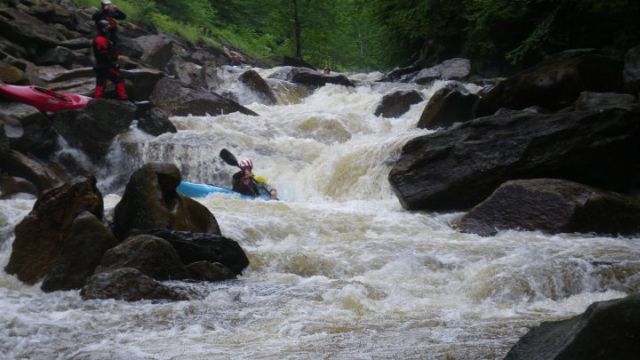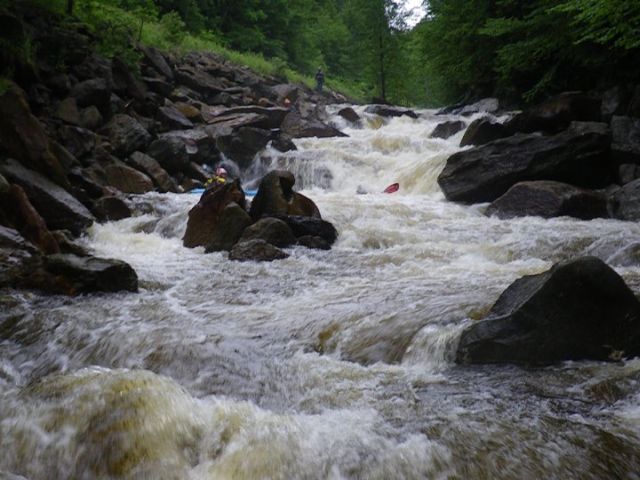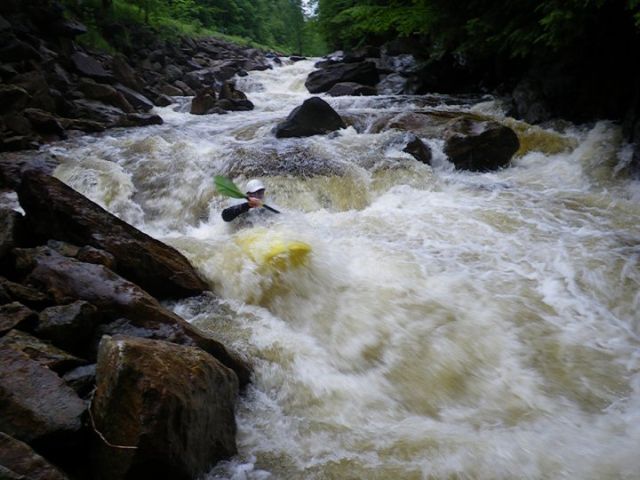| 1. This Dagger Vertigo kayak was pinned on the West Branch of the Deerfield, upstream of the town of Readsboro, VT. Released from it's watery rocky prison by MVP members Skip Morris and Paul Egbert. The boat had apparently been pinned there for quite a while. Update: The boat was pinned back on Oct 14, 2005. It was there almost nine months. Check out this NPMB Post for the original report. Also this NPMB Thread for the followup discussion of this recovery. [Editorial flame: I can't believe it was in there that long without being recovered (or came out in such good condition for that matter). Doesn't anyone bother to learn rescue and recovery techniques anymore? I know people accuse me of being "old-school" just because I learned to paddle whitewater in an aluminum canoe... but not being old is no excuse not to carry some minimal rescue gear in your trunk.] (IMAG0210a.JPG) |
| 2. This Class V drop is called Tunnel Vision for obvious reasons. The boat was jammed in a dangerous sieve along the left in the middle of the drop. I'd love to have seen how this boat got there. Update: The boater reported they scouted the drop but didn't notice a shift in the rocks had created a bad sieve on the left. At that level (at least), the ledge shoots boats right into the sieve. He was in the boat when it got stuck, but managed to get out just in time before it went further in/under the sieve. For future runs he recommends paddling hard right along that section of this drop. (IMAG0211a.JPG) |
| 3. The boat had been wedged tightly in place by the current (it was there during the entire late spring high-water of 2006). It also was completely full of river debris (rocks & sand), plus had a healthy coating of green slime growing on it. It wouldn't budge at all; a Z-Drag was required. (IMAG0212.JPG) |
| 4. The three pullys used in this small Z-Drag provided a 6:1 mechanical advantage allowing us to be able to to move the boat and lift it out of the current. We estimated, based upon the volume of the boat (64 gallons) plus lifting capacity of the Z-Drag, that the boat had approximately 500 pounds of rocks and waterlogged sand packed into it (in addition to the force of the current). (IMAG0214.JPG) |
| 5. Once out of the current, next step was the classic "Steve Thomas Rope Trick" to flip the boat over and empty some of the rocks out. (IMAG0215.JPG) |
| 6. Then, with a few of the rocks were removed, we were able to shove the boat on it's side onto the rock ledge (now totally out of the water). From there most of the rocks and sand were dug & scooped out of the interior of the hull making the boat light enough to lift. (IMAG0216.JPG) |
| 7. High-and-dry after most of the remaining rocks and sand were washed out in a pool. Boat was in good condition except for being a bit bent at each end, and that will straighten out after a few days in the sun. Total elapsed time for the whole process about two hours. [BTW: Rescue geeks would enjoy this really unusual use of a Z-Drag that I had fun with a while back.] (IMAG0218.JPG) |

| 8. Here's three shots of this drop at normal (ie, boatable) levels. The sieve is between the big rocks. These three shots taken by Kevin Lindberg in June 2010. (TunnelVision-KevinLindberg-FB1.jpg) |

| 9. (TunnelVision-KevinLindberg-FB2.jpg) |

| 10. (TunnelVision-KevinLindberg-FB3.jpg) |
| 11. Here's a couple of pictures showing this drop in very high water. The level when the boat was pinned was reported to be one foot (ie, not this high). (IMAG0094.JPG) |
| 12. These last shots were taken in the fall of 2003. (IMAG0095.JPG) |